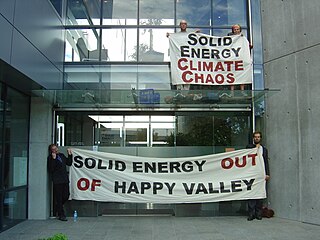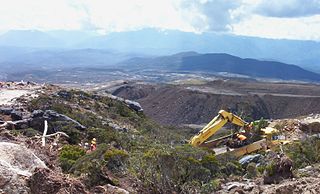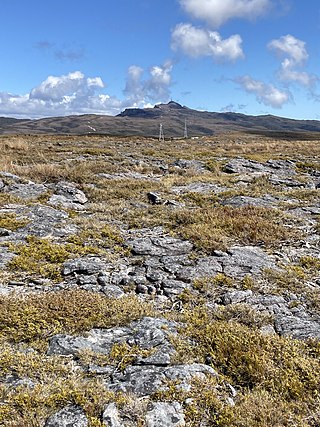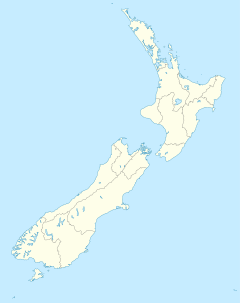Forest & Bird, also known by its formal name as the Royal Forest and Bird Protection Society of New Zealand, is an environmental organisation specialising in the protection and conservation of New Zealand's indigenous flora and fauna and unique wild places and natural ecosystems. Forest & Bird consists of 47 branches located in urban and rural centres throughout New Zealand. Branches are actively engaged in conservation projects and advocacy on a community, regional and national basis. Forest & Bird has offices and staff located in Auckland, Christchurch, Wellington, Nelson and Dunedin. Forest & Bird publishes a quarterly magazine Forest & Bird, one of New Zealand's definitive natural history and conservation publications.
This is a timeline of environmental history of New Zealand. It includes notable events affecting the natural environment of New Zealand as a result of human activity.
Denniston is a small settlement, 15 kilometres east of Westport, on the West Coast of the South Island of New Zealand. It is situated on the Denniston Plateau, 600 metres (2,000 ft) above sea level in the Papahaua Ranges.

The Save Happy Valley Coalition (SHVC) is an environmental activist movement formed with the express purpose of preventing the Cypress mine, an open cast coal mine on the West Coast of New Zealand, from proceeding.
Solid Energy was the largest coal mining company in New Zealand and is a state owned enterprise of the New Zealand Government.
The Papahaua Range is a mountain range on the West Coast of New Zealand's South Island east of the town of Westport. It is a geological continuation of the Paparoa Range that is south of the Buller River and it runs north from the Buller Gorge to the Mōkihinui River. At its north end, it meets the Glasgow Range.
The Timbarra Gold Mine was a highly controversial gold mine located on the Timbarra Plateau, at the head waters of the Clarence River, near Tenterfield, New South Wales, Australia. The gold ore body consisted of a greisen type granite. The protracted controversy attracted national and international attention, and catalysed an anti-cyanide extraction campaign in Australia.

Environmental Defence Society (EDS) is a not-for-profit environmental organisation based in New Zealand. It focuses on issues surrounding the Resource Management Act 1991 and is made up of resource management professionals who are committed to improving environmental outcomes within New Zealand.

Millerton is a small settlement in the northwestern South Island of New Zealand in the West Coast region. It is in the Papahaua Ranges, around 33 kilometres by road north of Westport, via SH67 from Westport to Karamea.

The Cypress Mine is a proposed extension to the open cast coal mine the Stockton Mine’s operational area, to the east into the Upper Waimangaroa Mining Permit area, on the West Coast of New Zealand.
The Mokihinui Hydro was a proposed hydroelectric dam and power station planned for conservation land on the Mōkihinui River on the West Coast of New Zealand. The project by Meridian Energy was expected to cost $300 million.

Mining in New Zealand began when the Māori quarried rock such as argillite in times prior to European colonisation. Mining by Europeans began in the latter half of the 19th century.
The Ngakawau Hydro Project is a proposed hydroelectric power station planned on the Ngakawau River in the northern section of the West Coast of the South Island of New Zealand. The project is being developed by Hydro Developments Limited.

Stockton Mine, on the Stockton Coal Field, is New Zealand's largest opencast mining operation. The entrance to the mine is at the former settlement of Stockton.

Denniston Plateau is an 18 km long, 600–800 m high coalfield plateau in the Papahaua Range on the West Coast of the South Island of New Zealand. A combination of impermeable rock, high rainfall, and shallow acidic soil has created a unique ecosystem of stunted trees and heath-like vegetation which is home to numerous endemic and undescribed species of plants and invertebrates. The plateau contains rich seams of high-quality coal, which led to the creation and abandonment of the mining towns of Denniston and Millerton, and the current Stockton Mine. Plans to create a new open-cast mine on the southern part of the plateau have become an environmental controversy.
The Mt William North Mining Project is a proposed coal mine planned for the West Coast Region of New Zealand.
The Rockies Incline was an inclined tramway on the West Coast of the South Island of New Zealand that for ten years from 1925 to 1935 brought coal from the Westport Main Coal Company’s mine on the Millerton-Stockton plateau down to the Westport to Seddonville railway line near sea level.

Arctesthes avatar, commonly known as the avatar moth or the Denniston triangle moth, is a moth of the family Geometridae and is endemic to New Zealand. It has been found in short-lived wetlands at elevations between 640 and 1000 metres, but only in the areas of the Denniston Plateau and the nearby Mount Rochfort in the Buller District of the West Coast Region of the South Island. The species was discovered by Brian Patrick in 2012, during a bio-blitz on the Denniston Plateau organised by Forest & Bird as part of a campaign against the planned development of an open-cast coal mine by Bathurst Resources. The name of the new species was proposed in 2012, following a competition run by Forest & Bird and judged by Patrick and his son. It was first described by Brian H. Patrick, Hamish J. H. Patrick and Robert J. B. Hoare in 2019. A. avatar has Nationally Critical conservation status under the New Zealand Threat Classification System.
Bathurst Resources, along with a number of subsidiaries, is a coal mining company in New Zealand that was established in 2010.

Mount Rochfort is a mountain peak 1,040 metres (3,410 ft) in elevation, located approximately 10 km east of Westport in the Buller District on the West Coast of the South Island of New Zealand. It rises above the south-west portion of the Denniston Plateau and overlooks the town of Westport and the plains of the Buller River.








